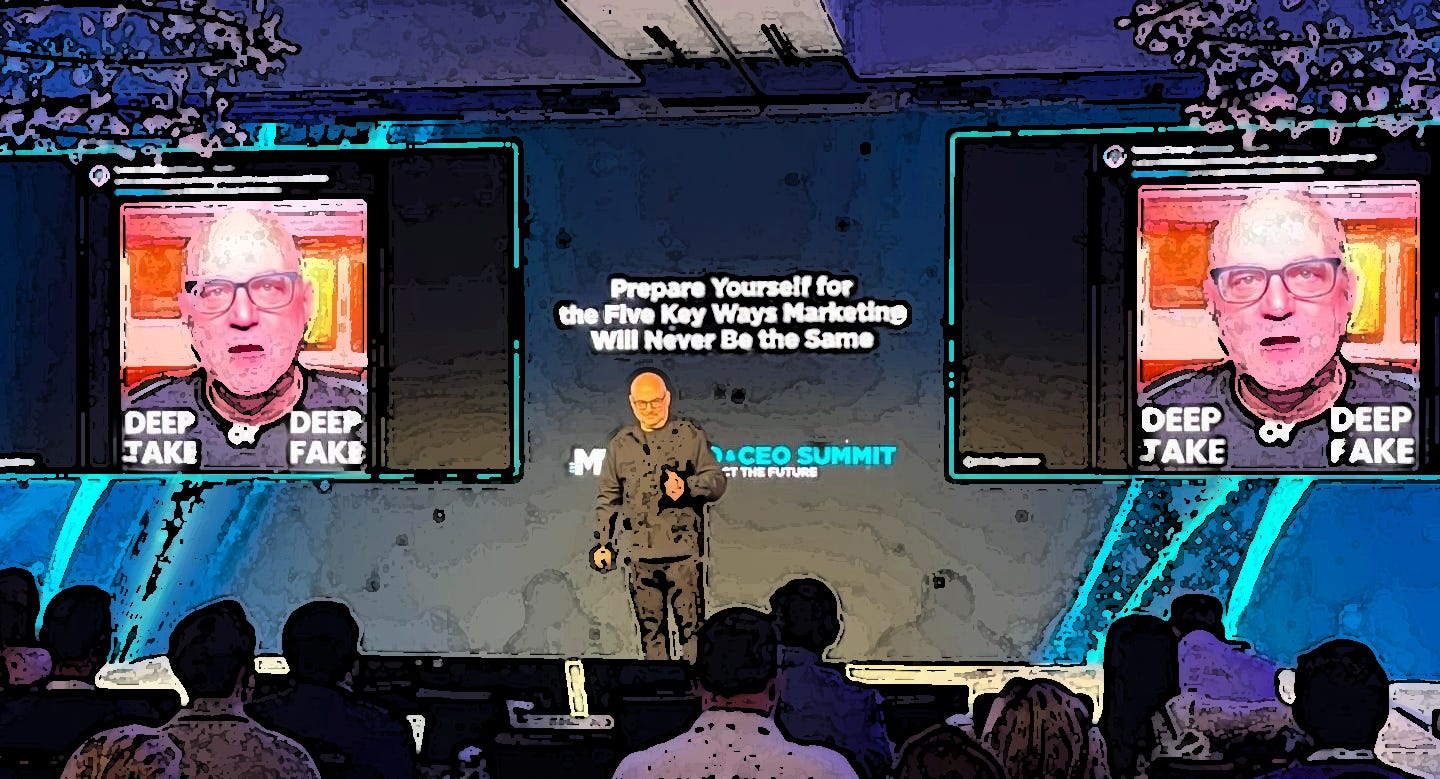PPPPath to Victory (Four Ps #242)
We Didn't Start the Fire: Part 3; How She Wins, The Post-Social Era & Summer Travel
It feels like a year has passed since the last Four Ps newsletter graced your inbox just two weeks ago.
In that time, we’ve ignited a spark...
A spark that has spread across the United States — To those of you who supported my plea for Joe Biden to step aside last time, your notes and comments have breathed new life into a stale race.
So, what will I challenge us with this week? Let’s light it up!
THE PERSONAL: Who Actually Started the Fire?
A year ago, Fall Out Boy re-recorded an updated version of Billy Joel's "We Didn't Start the Fire," covering the 30+ years since the song's original release.
And if the last two weeks felt like a year, the last year alone has felt like 3 decades.
And sitting with Lou Paskalis at breakfast in Napa last week, recapping the flurry of political, professional, even personal updates, he inspired me to write (but not record, in fear of the parodic wrath of Terry Kawaja) a third installment covering just the last few days, weeks, and months.
Crowdstrike outage, lights go down
Trump’s felonies, stirring up the town
Google cancels cookie plans, privacy on hold
Biden bows out, future yet to be toldUkraine war still at play, crypto boom and Apple Pay
UFO hearings, Pentagon’s say, will they come one day?
AI boom, ChatGPT, new tech growing endlessly
El Niño heatwaves high, climate change we can’t denyThreads versus Twitter, Musk and Zuck in bitter glitter
Billionaire’s space race, Branson, Bezos in the chase
Supreme Court crushing rights, chaos on election nights
Wildfires rage in Canada, smoke clouds the horizon farTrump returns, an orange creep, Nazis take over the GOP
TikTok ban debate, data privacy at stake
Getting rid of student debt, relief not coming yet
Travis Kelce + Taylor Swift, student protests, campus riftsCOVID’s back in new strain, vaccines rolling out again
Trump's bloody ear, What a year... Jews in fear
October 7: Israel attacked. Gotta get hostages back
Mass shootings, night and day. What else do I have to say?We didn't start the fire
It was always burning, since the world's been turning
We didn't start the fire
No, we didn't light it, but we tried to fight itKamala Harris, make a stand, first female leader of the land
A campaign filled with hope and grace, unity for every race
Appeals to young and diverse: The voice of progress will be heard
Change is coming, brighter days ahead, a new era on its way…
Ok, so maybe we didn't light it, but it’s time to fight it.
THE POLITICAL: How She Wins in November
Kamala Harris’s late entry into the presidential race last week has indeed revitalized the electoral landscape and breathed new life into what was a stodgy race between two old white men. Joe Biden had no chance of winning, but the Vice President does.
With the potential to sway key demographics in crucial swing states, her campaign strategy must be finely tuned to maximize these advantages and carve a clear path to the White House.
The 2020 election underscored the importance of swing states, with Biden clinching victory by narrow margins in Michigan, Wisconsin, Pennsylvania, Nevada, Arizona, and Georgia. For Harris, these states are pivotal, but her strategy has to be slightly different from Biden’s.
Harris’s appeal among nonwhite voters presents a unique opportunity to flip or secure states with significant Black and Hispanic populations in various regions.
Southern Strategy: Georgia and North Carolina: Both states have substantial Black populations (33% and 21%, respectively). Harris’s campaign should highlight her advocacy for racial justice, economic empowerment, and voting rights. Mobilizing grassroots movements and leveraging her personal narrative could resonate deeply with these communities.
Sun Belt: Nevada and Arizona: With over 20% of the electorate being Hispanic, Harris’s message must include robust immigration policies and economic initiatives that address the concerns of Hispanic voters. Her platform should emphasize job creation, healthcare access, and educational opportunities to gain traction.
While Harris might have a tougher time in the traditionally working-class Rust Belt, she can win with independent voters where the economy is more important than border concerns across Michigan, Wisconsin, and Pennsylvania. A dual approach is needed:
Economic Renewal: Emphasize job creation, infrastructure development, and support for local industries. Harris should draw parallels between Biden’s legislative successes and her vision for a robust, inclusive economy.
Labor Rights: Strengthening ties with labor unions and advocating for workers’ rights can help bridge the gap with working-class voters who may feel disenfranchised.
The Harris campaign should also go much further in recruiting undecided female voters. Amid a “huge, historic gender gap” among young voters, Trump’s team will be pushing a chest-beating macho appeal, a stark contrast with Harris's pro-choice, pro-equality rights-dominated inclusivity focus.
So what's the message? Joining the various Zoom calls over the past few days, it's becoming clear that Harris’s campaign is centering on a theme of “The Dignity of Work and Shared Prosperity.”
This message addresses economic concerns while acknowledging the societal contributions of every worker. Concrete proposals like tax reforms favoring labor income, investment in childcare, and universal healthcare will be key. Like Obama did 16 years ago, creating forums for community input on technological and environmental transitions can demonstrate a commitment to democratic renewal.
It's not going to be easy, but she can do it. Kamala Harris has a viable path to victory. With a compelling economic and social narrative, and by showing humility, compassion, and toughness, she can navigate the complexities of the electoral map and energize the base necessary for a triumphant campaign.
THE PROFESSIONAL: From Social... to So What... to Now What?
At the annual MMA CEO & CMO Summit last week in Napa (where COVID may have been the biggest takeaway), there were zero mentions of the metaverse, Roblox, or blockchain. However, there was plenty of talk about AI and retail media. The great Shelley Palmer took the stage against the backdrop of an AI-generated Shelley Palmer to remind the room (and the world) that we have officially moved from the "Age of AI Curation to AI Generation," and challenged us all:
"If you’re not testing, learning, and failing now, you’ll fail for good."
I said the same thing nearly 16 years ago inside a conference room somewhere in New Jersey to a team of marketers who were curious about what social media could mean for marketing.
But that once-noble spark has resulted in a blaze now burning out of control.
For teens and others, I've seen (first-hand) the devastating impact that social media can have on bullying and bad decision-making. This is why we should also acknowledge and praise Meta for partnering with the Center for Open Science to let researchers access Instagram data to study its impact on teen mental health, potentially yielding insights into the relationship between social media use and well-being.
For brands and marketers, we've actually reached a saturation point.
In 2023, brands found themselves publishing an average of 10 posts per day across social networks, contributing to an overwhelming flood of content. Sprout Social's analysis indicates we’ve hit a peak in terms of content saturation, making it increasingly difficult for consumers to engage meaningfully with the vast amount of content (and now, ad inventory) available.
A staggering statistic shows that our attention spans have plummeted from 2.5 minutes in 2004 to just 47 seconds in 2023, underscoring the challenge brands face in capturing and maintaining audience interest.
So, how can brands cut through the noise? The key lies in investing in unique, original content. Sprout’s Social Index reveals that nearly 40% of consumers remember brands that prioritize original content over trendy, repetitive posts. This highlights the importance of creativity and authenticity in standing out. (And what about Threads?)
Marketers must also delve deeper into understanding their audience's niche preferences. Identifying where your audience spends the most time and what type of content resonates with them—be it text, images, or videos—can significantly enhance engagement. This tailored approach ensures that your content isn’t just adding to the clutter but is genuinely connecting with your audience.
It's also only a matter of time before retail and commerce media hit a similar saturation point.
Retail Media Networks struggle with limited display inventory, relying on social platforms and offsite platforms to meet demand and fulfill obligations.
The results are declining ROI, rising CAC, and limited ownership of their data, content, and relationship with consumers.
Sounds like you're paying for more and getting less.
It’s easy to feel discouraged by saturation stats, but it’s crucial to stay optimistic and keep your creative efforts alive, while innovating with new platforms to bring new and renewed value. Redefine what success means for your brand, focusing on more targeted engagement goals rather than sheer numbers.
This shift in perspective can help you navigate the saturated landscape more effectively and maintain a meaningful connection with your audience.
THE PODCAST: Innovation, Illumination, Incarceration
ICYMI: Two incredible and entertaining episodes of the Snarketing Podcast in July:
Cherian Thomas is leading the way with innovative solutions for Retail Media, digital out of home, partnering with the likes of Uber and even PDP optimization specialists to deliver on an optimized, full-funnel consumer experience.
Vincent Bragg went from running a cocaine empire to leading an award-winning creative agency, ConCreates. These episodes are packed with laughter, insights, and jaw-dropping stories!
THE PRACTICAL: Should You Stay or Should You Go Away?
The analytics on this post will soon tell me whether I'm right or wrong, but many of you are reading this post somewhere other than your home or office.
Welcome to what is expected to be the biggest summer for travel in recorded history.
Yet, with prices (and temperatures) so high, marketers might be wondering if it’s even worth incorporating travel and vacations into their messaging for the summer.
Hold onto your flip-flops, folks, because Deloitte’s 2024 Summer Travel Outlook is here, and it’s as hot as your neighbor's backyard BBQ.
Spoiler alert: Americans are itching to hit the road, but with a twist. They're craving “elevated and unique experiences” – because who wants a basic beach vacay when you can have a yoga retreat on a llama farm?
About 60% of Americans are packing their bags this summer, according to Deloitte’s survey of 4,000 wanderlust-filled souls. However, a whopping 42% are staying put – a tad more than last year’s 37%. The culprit? Cold, hard cash. Yet, people are still overwhelmingly willing to spend on experiences over luxury goods.
Here’s the kicker: 32% of non-travelers say travel is too pricey, up from 24% last year. Another 39% simply can't afford it, while 19% would rather spend their moolah on, I don't know, avocado toast or something. Only 7% are worried about health risks, and 6% are bracing for potential travel chaos – because who isn’t nowadays?
And while many Gen Z and Millennials talk about experiences, doing so in tighter economic circumstances is not as easy. Meanwhile, more Boomers are out in full force, leading the charge with their fanny packs and SPF 50. They make up 34% of travelers, up from 28% last year. Households raking in over $100K are also splurging big time, turning vacation budgets into mini-fortunes.
But yes, Gen X, Millennials, and Gen Z? They’re still in the game with 24%, 30%, and 9%, respectively.
So, if you’re a brand aiming to catch these eager explorers, think beyond the ordinary. After all, no one wants just another beach trip when they could be sipping artisan kombucha in a treehouse.
Happy travels, everyone!
(Speaking of travel and time off, the Four Ps will be skipping a week for summer break, back the week of August 19. Try not to miss us!)








